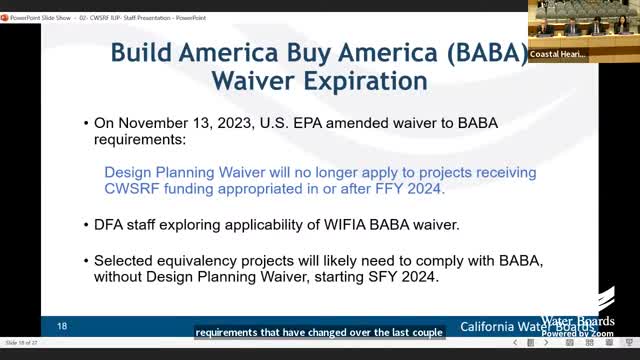EPA's New Rules Transform Infrastructure Funding Landscape
July 03, 2024 | State Water Resources Control Board, Agencies under Office of the Governor, Executive, California

This article was created by AI summarizing key points discussed. AI makes mistakes, so for full details and context, please refer to the video of the full meeting. Please report any errors so we can fix them. Report an error »

In a recent government meeting, officials discussed the implications of the \"Build America, Buy America\" requirement, which emerged from the bipartisan infrastructure law. This mandate, aimed at promoting domestic manufacturing, will soon eliminate a transition period waiver that previously exempted projects in planning or design stages from compliance. As a result, new projects initiated this year will be subject to these requirements, marking a significant shift in how federal funds are allocated.
The Environmental Protection Agency (EPA) has been actively providing guidance on this transition, emphasizing that while not every project must comply, an equivalency requirement will apply to projects funded in proportion to federal capitalization grants. Officials indicated that they would prioritize larger projects already co-funded by federal sources to meet these new standards, thereby minimizing the number of projects affected.
Concerns were raised regarding the availability of domestically manufactured materials, particularly in the water sector, where certain products, like plastic pipes, are not produced in the U.S. The EPA is expected to utilize specific waivers to address these challenges, allowing for flexibility in compliance. This includes an availability waiver for certain products and a de minimis waiver that permits projects to exclude minor items from reporting.
The meeting also highlighted a memo from the EPA reminding states that all funds from capitalization grants should be committed within a year of receipt. California's Clean Water State Revolving Fund (SRF) program was recognized for its efficiency, ranking first nationally in fund commitment metrics, while the drinking water program ranked third. This success is attributed to innovative funding strategies that allow for quick project initiation, although it requires extensive tracking and management efforts from staff.
Overall, the discussions underscored the complexities and challenges of implementing the \"Build America, Buy America\" requirements while maintaining efficient use of federal funds in infrastructure projects.
The Environmental Protection Agency (EPA) has been actively providing guidance on this transition, emphasizing that while not every project must comply, an equivalency requirement will apply to projects funded in proportion to federal capitalization grants. Officials indicated that they would prioritize larger projects already co-funded by federal sources to meet these new standards, thereby minimizing the number of projects affected.
Concerns were raised regarding the availability of domestically manufactured materials, particularly in the water sector, where certain products, like plastic pipes, are not produced in the U.S. The EPA is expected to utilize specific waivers to address these challenges, allowing for flexibility in compliance. This includes an availability waiver for certain products and a de minimis waiver that permits projects to exclude minor items from reporting.
The meeting also highlighted a memo from the EPA reminding states that all funds from capitalization grants should be committed within a year of receipt. California's Clean Water State Revolving Fund (SRF) program was recognized for its efficiency, ranking first nationally in fund commitment metrics, while the drinking water program ranked third. This success is attributed to innovative funding strategies that allow for quick project initiation, although it requires extensive tracking and management efforts from staff.
Overall, the discussions underscored the complexities and challenges of implementing the \"Build America, Buy America\" requirements while maintaining efficient use of federal funds in infrastructure projects.
View full meeting
This article is based on a recent meeting—watch the full video and explore the complete transcript for deeper insights into the discussion.
View full meeting
